31 Days, 31 Lists: 2023 Unique Biographies for Kids

A good biography is one thing. A unique biography is another thing entirely. A great many of the darn thing are published every year, and it can be just a touch difficult to wade through them. I like a good one, though. I like a biography that makes you interested in another person’s life on the one hand, while also opening their story up in some larger way on the other. Today, I’m celebrating those biographies that focus on their subjects with a bit of creativity. The ones that could only tell their tales their own particular ways. Biographies for the masses! Biographies for the kids.
If you’d like a PDF of today’s list, you can find one here.
Curious about previous years’ biography lists? Then check out what’s come before:
2023 Unique Biographies for Kids
Beautiful Noise: The Music of John Cage by Lisa Rogers, ill. Il Sung Na
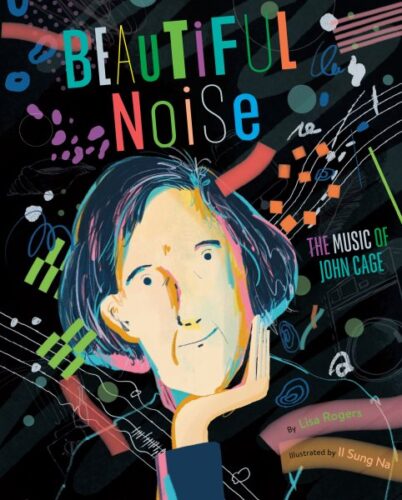
Boy, it sure does make a difference what illustrator is paired with a given book at a given time. I’m not saying that writer Lisa Rogers hasn’t done a stand up and cheer job here. She has! I’m just saying that if these words had been paired with so-so art, I’m not so sure the final product would be anything to write home about. Fortunately, a good editor knows when to make the call and hire a great artist. Il Sung Na was always been better known to me personally for his work on The Book of Sleep and such. I’ve never seen him try his hand at a picture book bio, and he does not disappoint. First off, let’s talk endpapers! Using shapes and colors to represent different sounds, you could have an extended conversation with a kid over whether or not “Miffed” or “Murmuring” look the way Na has depicted them here. The book itself is my favorite kind of picture book bio. Which is to say, the kind that doesn’t go the “Such n’ so was born on [blank] to [blank] and when his mother saw him she said [blank]”. Booooring! Instead, Rogers had to think long and hard about what the point of a John Cage picture book bio would have to be. Her answer? How all sound, or even lack thereof, can be music. Do you want to get a clear cut explanation about why Cage wrote a four minute and thirty-three second piece where the pianist didn’t play a single note? It’s a beautiful dual bio of Cage and of Cage’s music equally. The best book to pair this with might actually be The Noisy Paint Box by Barb Rosenstock about Kadinsky. Worth discovering.
ADVERTISEMENT
ADVERTISEMENT
The Brilliant Calculator: How Mathematician Edith Clarke Helped Electrify America by Jan Lower, ill. Susan Reagan
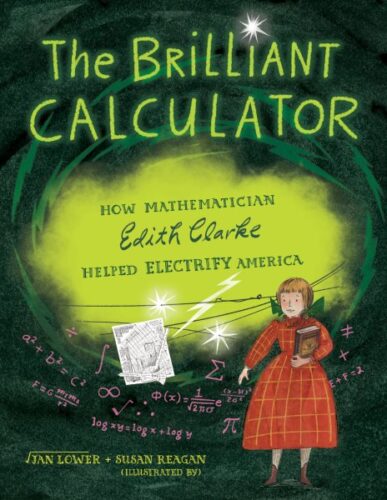
Oh, me oh my, I DO so love a good picture book biography when it has something to do with math. And as I mentioned before, over the last 10 or so odd years there’s been a notable uptick in the marketplace. I wonder, though, if you were to look at which publishers create such books, would the same names come up time and again? For example, the Calkins Creek imprint appears to be better suited to publishing a book of this sort. Why do I say such things? Because when I read a book like The Brilliant Calculator about Edith Clarke I notice several smart choices throughout. Fake dialogue? Not present. Is the story itself more fun than the backmatter? You betcha. Plus this is a smart duo of author and artist to pair together. Lower’s A Song for the Cosmos: Blind Willie Johnson and Voyager’s Golden Record was an accurate but dreamy take on its subject matter, while Reagan’s work on Revolutionary Prudence Wright elevated a book that might not have gotten attention otherwise. Here they have to prove their mettle in one specific way: Are they afraid of numbers? I’m not kidding about this. Many is the mathematician bio that eschews almost any mention of actual math (check out the bulk of books on Katherine Johnson if you don’t believe me). Ms. Reagan does include math in the details of the art, though the equations reminded me of the year I served on the Mathical Prize committee and the mathematicians there started trying to solve the math in the art that they found in such borders. But with her accurate rendition of the Clarke Calculator patent, I am certain everything checks out. Great writing, an interesting person to learn about, and some truly awesome art. A winner! Previously Seen On: The Math List
Chef Edna: Queen of Southern Cooking, Edna Lewis by Melvina Noel, ill. Cozbi A. Cabrera
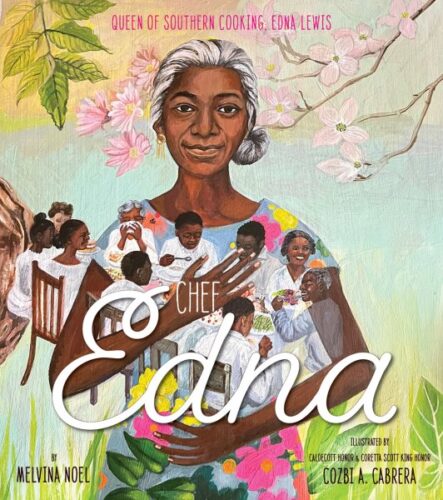
How did one southern woman manage to charm the whole of New York City with her cooking? The triumphant tale of family, home, and delicious biscuits. Cozbi’s back! Evanston’s very own Cozbi A. Cabrera has a new picture book bio she’s illustrated, though I admit that when I saw this striking cover I didn’t immediately recognize that it was her. I’ve actually purchased some of Edna Lewis’s cookbooks for my library’s collections before, so her face here was instantly recognizable. Like a lot of picture books about cooks, it’s important to see how the author frames their subject’s life. Here, Melvina Noel has chosen to fixate primarily on Edna’s family and southern home. She doesn’t elide the hardship but she also makes it clear how closely Edna is tied to that part of the country, even after she moves to New York and becomes a success. I thought the writing worked beautifully but it’s Cozbi’s art that makes this more of a standout than your usual bio.
Contenders: Two Native Baseball Players, One World Series by Traci Sorell, ill. Arigon Starr
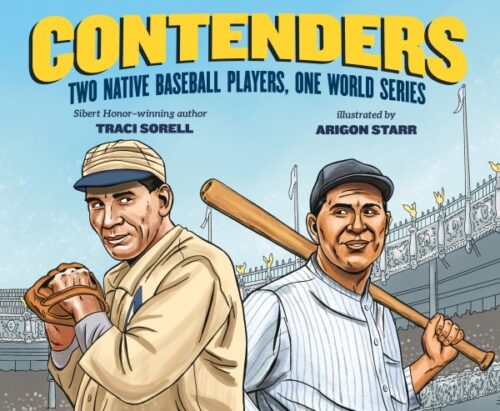
I’m just trying to remember the publishing scene even ten years ago and how likely it is that a book like Contenders would have even (A) come out and (B) been as beautifully lauded and advertised as this particular book has been. The name “Traci Sorell” undoubtedly sounds familiar to you. That’s probably because she’s done such critically acclaimed titles as We Are Grateful: Otsaliheliga and We Are Still Here! Native American Truths Everyone Should Know. Here she creates a dual biography that starts with a big moment, then pulls back to fill in some biographical info. In the 1911 World Series, the only two Indigenous baseball players in the major leagues faced off against one another. Naturally, the press at the time was just awful about it. Never alleging or filling in with fake dialogue or committing really any of the usual bio sins, Sorell tells the background stories of Charles Bender and John Meyers adeptly. They had a couple things in common, but in many ways they led incredibly different lives. I was particularly pleased when I saw the eight additional Native players listed since 1911 that have played in the majors. Artist Arigon Star presents them like baseball cards, while at the bottom of the page you have depictions of racist white fans with tomahawks and facepaint facing off against Native activists, their fists raised high. A powerful telling with fantastic backmatter. Previously Seen On: The American History List
Desert Queen by Jyoti Rajan Gopal, ill. Svabhu Kohli
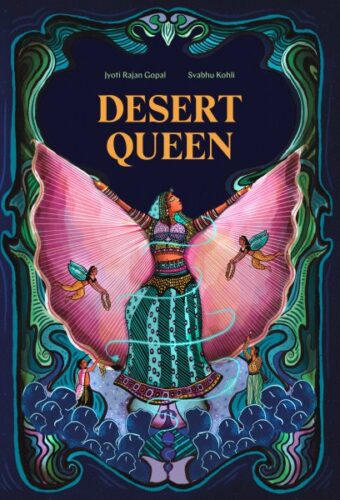
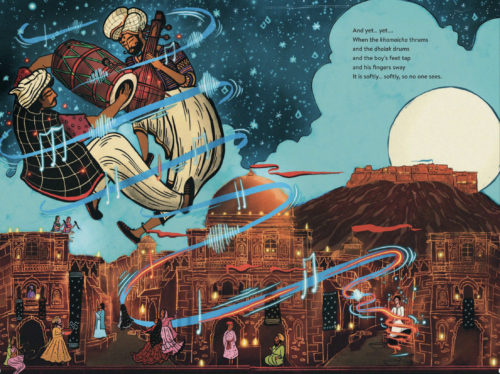
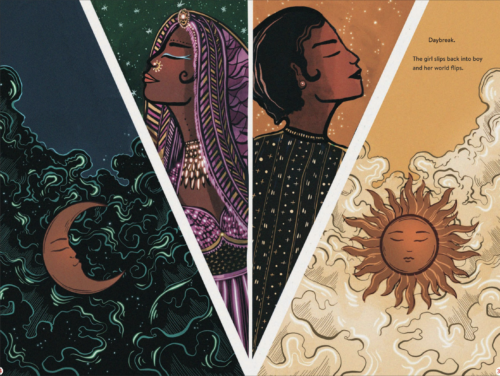
This one’s cool. It’s probably safe to say that this is the first picture book biography on Harish Kumar/Queen Harish to ever come out, and how nice that when it has it’s as beautiful as it is. It’s difficult to know where to begin to tell this story, but Gopal takes a steady hand to the story of how Kumar became the Rajasthani folk dancer and drag performer Queen Harish:
A biography has a number of different ways that it can convey the life of its subject. Here, Gopal eschews a standard this-to-this-to-this methodology, preferring instead to tap into the emotions of the subject. The text is fairly simple and, compared to some picture book bios I’ve seen this year, downright sparse. Kumar’s transformation into Queen Harish is also remarkable, thanks in large part to the art by Svabhu Kohli. When the text reads, “The boy is shiny and glittery and NEW” that just feels like the mildest description for the art on the opposite page. There, Queen Harish is emerging from a universe in the shape of a man splitting down the center, great lines of light weaving around her, and a new universe forming. And when she dances? Remarkable. Would I have liked a little more backmatter? Heck yes. Always. But there’s an author’s note there with further information on Kumar, so at least we’re not left hanging entirely. The most beautiful drag picture book bio I’ve ever had the chance to see.
And yes. When I read this title I do get “Dancing Queen” stuck in my head. *sigh*
The Fire of Stars: The Life and Brilliance of the Woman Who Discovered What Stars Are Made Of by Kirsten W. Larson, ill. Katherine Roy
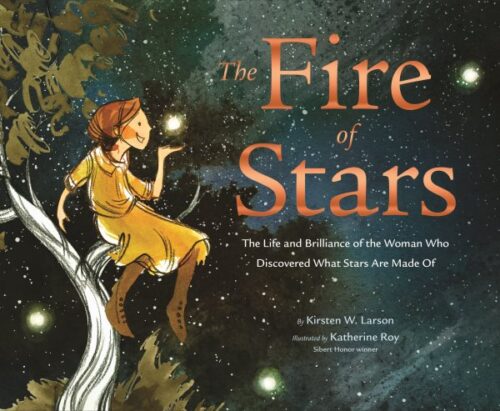
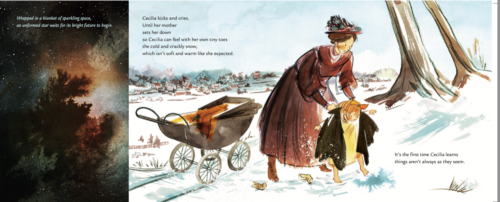
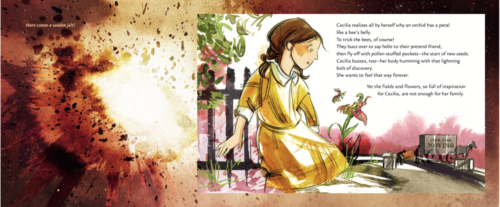
What burns at the heart of a star? The story of Cecilia Payne, ground-breaking scientist, is brought to life in this scintillating picture biography riddled with the mysteries of the universe. In spite of the fact that the subtitle of this book ends with a preposition and completely fails to name its biographical subject on the cover (the longer I look at it, the weirder it gets) this is a stand up and cheer example of how you can take a biographical subject and eschew the rote categorization of their life when you write a book about them. While most picture bios of female astronomers do a dull play-by-play of their life. Larson shakes things up by pairing Cecilia Payne’s discoveries alongside the birth of a star. She has Katherine Roy, science illustrator extraordinaire, there to help her. If you want to have some fun, play attention to how the star information slowly consumes everything behind Cecilia’s biographical history. Also look at how Roy plays with the color yellow in Cecilia’s clothing. No fake dialogue, a surprising story, and great backmatter. Better, by far, than a good chunk of what’s already out there. Previously Seen On: The Science and Nature List
Friend of Numbers: The Life of Mathematician Srinivasa Ramanujan by Priya Narayanan, ill. Satwik Gade
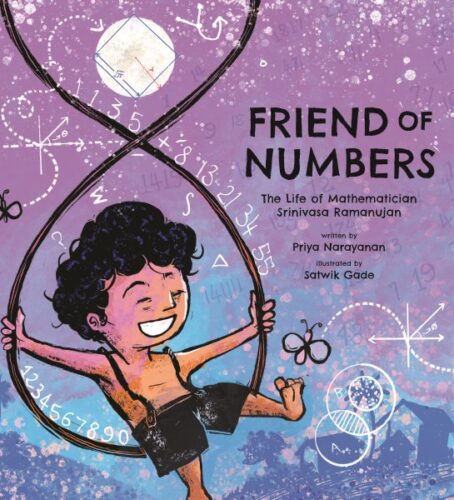
Every single picture book biography out there is a challenge in an entirely different way. The author of such a book must determine the best possible way in which to introduce their subject without going the rote, “Mr. [Blank] was born on [Blank] in the country of [Blank].” You see what I’m getting at. Now add in an additional terrifying factor: Math. Math complicates things for authors. Very few children’s book creators have degrees in it. Many retain fears of it dating back to their own school age years. So when some of them write picture book bios of mathematicians they try to avoid the math in any way that they can. They may, for example, lean heavily on the illustrator to put numbers, charts, and graphs in the art (though, as I mentioned before, I’ve been with mathematicians who have looked at these art pieces and said, “This is just gobblety-gook!”). So one of the differences with Friend of Numbers is the the fact that not only does Priya Narayanan have a good grasp on how to tell the story of Srinivasa Ramanujan, but she also isn’t afraid to put math into the text itself. I was reminded of The Boy Who Loved Math by Deborah Heiligman, another book that understood innately how not to shy away from numbers. Satwik Gade’s art is just as enticing, and I was delighted to discover that this edition we’re seeing here in America is a reprint of a book that originally came out in India. In the front it says, “The author’s note, glossary, and mathematical content were created in collaboration with the author for the Eerdmans edition of this book.” You know what that means, don’t you? In other countries there isn’t a focus on backmatter, but here in the States we rather insist on it. And this book’s backmatter is INCREDIBLE! From the Author’s Note to different types of patterns that kids can practice on their own to a Glossary, this book is one of the best math-related titles for kids I’ve seen in a long long time. A glorious example for other publishers importing nonfiction from overseas. Previously Seen On: The Math List
The Green Piano: How Little Me Found Music by Roberta Flack with Tonya Bolden, ill. Hayden Goodman
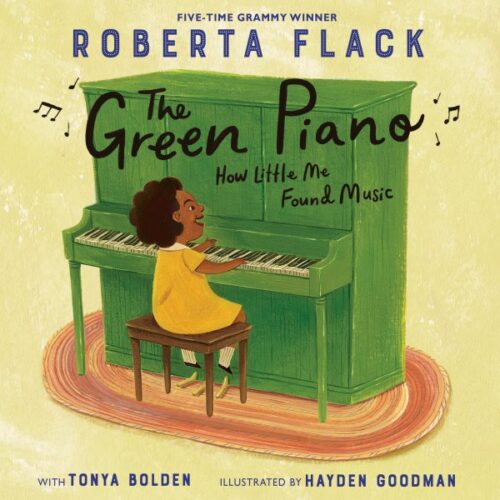
A five-time Grammy Award winner tells the story of how she came to love music and how her family got its very first piano. Loads of personality and fun infuse this delightful tale. Oh, I liked this! I was really worried at the start because initially I missed the fact that Ms. Flack was the actual author of the book. As a result I started getting really huffy about the fact that it was written in the first person. Shows what I know. Here, Roberta’s voice comes through with so much zip and pizzaz and pop! Plus the nerd in me just got really excited watching her dad fix up that old piano. A picture book bio that actually feels like kids would enjoy reading it. Fun!
Holding Her Own: The Exceptional Life of Jackie Ormes by Traci N. Todd, ill. Shannon Wright
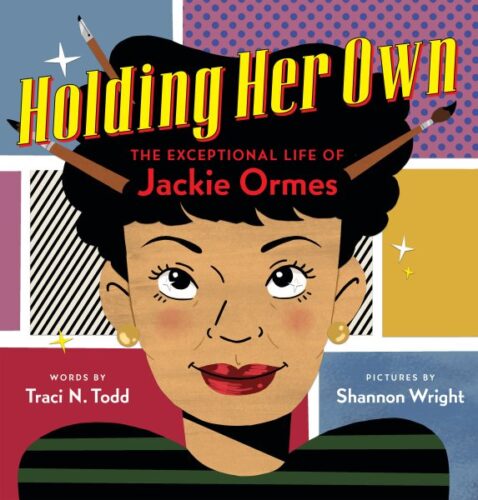
The life of reporter, cartoonist, dollmaker, artist Jackie Ormes is brought to rip-roaring life in this fun and fantastic biography. Learn as much as you can about the first Black woman to become a nationally syndicated cartoonist! This is a unicorn! A picture book biography about a funny Black woman who broke into the comic strip business. My husband’s a real comics history guy so when I asked him about Jackie Ormes he knew who she was but was unaware of how much she did. Sure, he’d heard about her Torchy series but not her Patty-Jo. The book’s written with a lot of humor and then Traci N. Todd (possibly best known to us for illustrating Varian Johnson’s graphic novel Twins) just goes above and beyond the call of duty to make the art as interesting as possible. My favorite two-page spread is the Family Circus-esque look at her travels as a reporter. This is top notch, original, and worthy of its subject. No small feat.
Imagine a Garden: Stories of Courage Changing the World by Rina Singh, ill. Hoda Hadadi
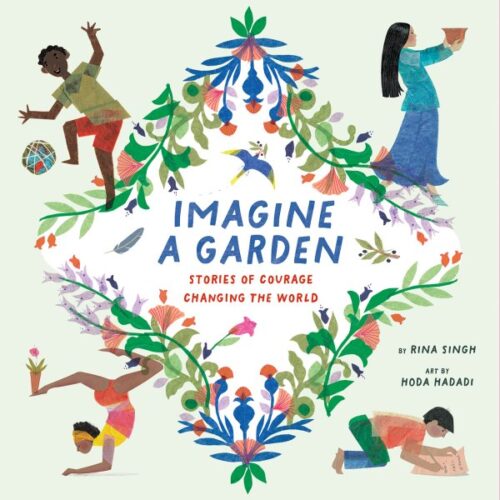
A rather clever set up for a relatively simple creation. On its bookflap you’ll see that the book describes itself as “a collection of seven vignettes from around the world.” What’s remarkable, though, is that each of the people featured is, indeed, a real person. Cut paper art is what helps to tell their stories, which are presented as free-verse poems. I know. That sounds dangerously close to precious. I assure you, though, that Rina Singh is very good at hitting the right tone with each of these tales. Part of what I like about them is how small each one is. The teacher in Delhi who has class under the trains’ bridges. The artist that turns weapons into instruments in Mexico City. And Autumn Peltier is having a particularly good year, appearing in both this book and Autumn Peltier, Water Warrior by Carole Lindstrom. Don’t look for any bibliography in the back. There is some backmatter in the end that gives further information about each person, as well as an Author’s Note that talks more personally about the reason for this book. It’s a quieter kind of collection bio than we usually see (and shorter!) but it’s one of the few I could actually see you reading aloud to a group.
The Indestructible Tom Crean: Heroic Explorer of the Antarctic by Jennifer Thermes
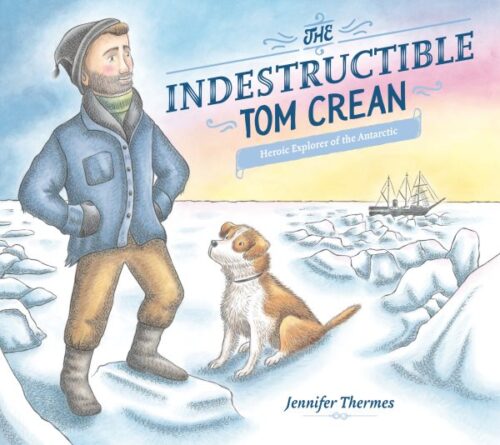
Sail with explorer Tom Crean on the ships Discovery, Terra Nova, and Endurance and watch as the man not only manages to stay alive but also saves the lives of his fellow crewmen time and time again. A gripping, wonderful look at a heroic man. First up, I’d like to mention how much nicer it is to read books about Antarctic exploration than Arctic exploration, since at least on Antarctica they didn’t have any native populations to exploit. This is a gutsy, gripping story of a regular guy who just happened to have exactly what was needed to survive over and over and over in impossible situations. It’s nutty to think how he just kept on going back to that frozen wasteland. It doesn’t shy away from the less pleasant stuff (like the fate of his dogs on one of the trips) and reading about that last trip to try and save Shackleton’s crew had me on the edge of my seat. Thermes did a book about Manhattan a year or two ago that I liked (Manhattan: Mapping the Story of an Island) but honestly, I like this one far more. You’ve gotta see it for yourself.
The Little Books of the Little Brontës by Sara O’Leary, ill. Briony May Smith
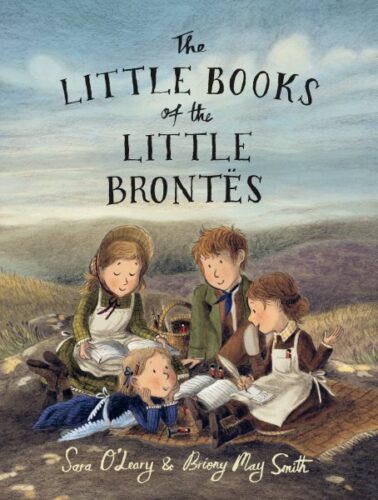
A biography written for children does not have to follow a set path. This is not to say that there aren’t rules. A good picture book biographer ideally does not rely on fake dialogue or start making up scenes that did not occur, just because it gives the story a little more oomph. An author is more than allowed to do this, but if they do then the book becomes “informational fiction” and shouldn’t really be considered nonfiction at all. At the end of this book, author Sara O’Leary states that, “There is much material of their [the Brontës ] later lives, but we can only imagine what their early years were really like. I choose to believe that theirs was a childhood not so much marked by poverty and deprivation but one that was rich in both stories and love. They had each other. They had their books.” Those little books that the Brontës made for one another are the catalyst for the storytelling taking place here today. Now I once sat in on a panel where a fine author of children’s nonfiction stated that while the writing of a book for children may adhere close to the facts, the art never can. We can never truly know if this person stood in this particular way at this particular time at that particular place. Maybe a photograph indicates that they did, but you could never get every detail completely correct. With that in mind, all illustration in nonfiction is, after a sense, an untruth. So it is that some may see the kids in this book having a good time with one another and disapprove, but I think that O’Leary has plenty of evidence on her side to back up the theory that they had a bit of fun in their lives. Besides, it’s rather nice to see four siblings enjoying one another’s company, against a backdrop of gloomy moors and skies. And if you learn a thing or two about them along the way, and get a sense of how writing for fun may lead to being a real author someday? All to the good!
Make Way: The Story of Robert McCloskey, Nancy Schön, and Some Very Famous Ducklings by Angela Burke Kunkel, ill. Claire Keane
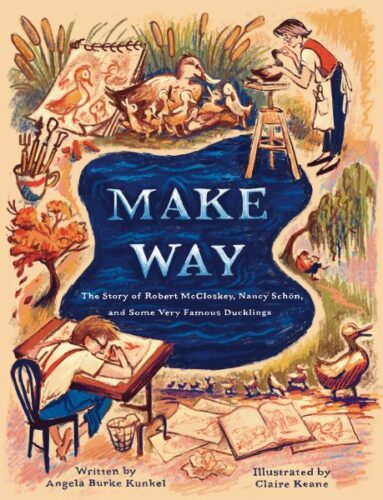
One man created a story of ducks that became a picture book classic. One woman created sculptures from the book that became beloved Boston icons. But how the two came to be? That’s the story you haven’t heard. Color me impressed. Last year we saw a picture book bio of McCloskey and his creation of Make Way for Ducklings and it was just that. A kind of cute story behind a story. Angela Burke Kunkel takes a different and (quite frankly) smarter approach. She pairs McCloskey alongside artist Nancy Schön and then the two of them come together in an honestly tense scene near the end. Claire Keane’s always had such a great style to her art, but this is the first time I’ve seen the text match her illustrations. I loved her waterlogged McCloskey and the vibrancy she gives these characters. No fake dialogue. Lots of good backmatter. And best of all it’s a picture book dual biography that I honestly think a kid would want to hear again and again. That’s rare!
Major Taylor: World Cycling Champion by Charles R. Smith Jr., ill. Leo Espinosa
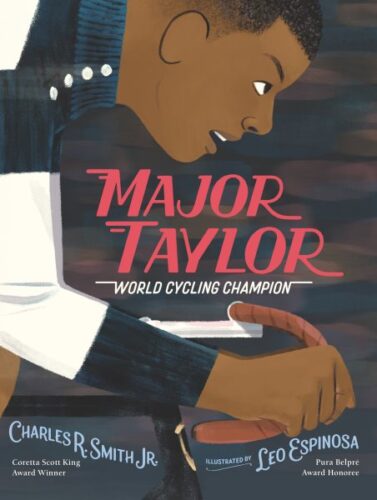
You just have to hand it to Charles R. Smith Jr. The man never tries to take the easy way out. We’ve seen picture book bios of Major Taylor before, but I think this has to be my favorite. Not simply because it does clever things with flashing back and forth between one particular race and the earlier parts of his life, but because Smith makes the whole thing rhyme. Talk about a challenge! And the kicker is that he’s particularly good at it. I mean, of course he is. He’s a poet for crying out loud. But Smith’s other superpower is his ability to make rhyming nonfiction really plunge you into the action. So here we have Major Taylor neck and neck with these white guys on their bikes (Espinosa is really pulling out all the stops with their handlebar moustaches) and the action reads, “Go faster go faster / so they can’t catch you – / GO, MAJOR, GO, / don’t let them crash you!” I can envision a teacher really getting into this, pulling the listening audience into the action, as the bikes careen around and around and around. And Espinosa is doing some amazing work with the art here as well. This is a very different style from the one we saw with the incredible The World Belonged to Us by Jacqueline Woodson. Here it’s less stylized and more realistic. I wouldn’t change it for anything in the world. A bright star in the pantheon of sports picture book bios.
Mary’s Idea by Chris Raschka
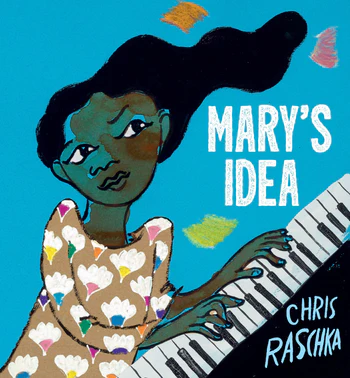
“It was Mary’s idea to play the piano at three.” A visually clever encapsulation of the life of Mary Lou Williams, told with Chris Raschka’s inimitable style. A rather good complementary title to the aforementioned The Green Piano, as it happens. Raschka has always had a weakness for picture book bios (but not standard, rote ones) of jazz greats. Looks like Mary Lou Williams fits the same bill. But what’s so interesting here is how he focuses so entirely on her hands. It reminded me of a variation on his book New Shoes he put out a couple years ago that was all foot p.o.v. related. I like how this one is laid out. The way the hands reach out, it’s like her hands are your hands. It melds his artistic inclinations pretty neatly with something a kid would enjoy.
Santiago Saw Things Differently: Santiago Ramón y Cajal, Artist, Doctor, Father of Neuroscience by Christine Iverson, ill. Luciano Lozano
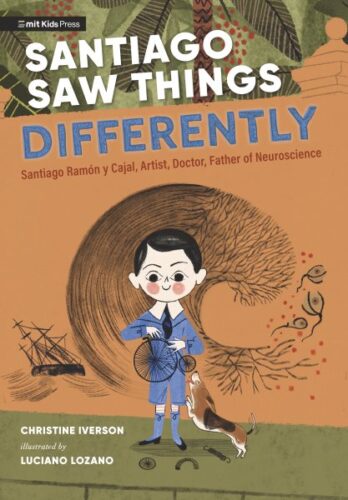
Now, to be perfectly fair, any book that has to follow the graphic biography Santiago! Santiago Ramón y Cajal – Artist, Scientist, Troublemaker by Jay Hosler has a tough road to hoe. The advantage that Iverson and Lozano have here is that while that book was a comic for older readers, this is quite clearly a picture book biography. As such, it eschews some of the violence of Santiago’s life (and does not begin, as Hosler did, with its titular hero getting kicked in the head by a horse… or was it a mule?). Here, it’s a rather visually stunning encapsulation of the life of a boy who was able to combine art and science in a way that made difficult concepts clear to others. Forced by his father to study to become a doctor rather than an artist, it was Santiago who figured out how to sketch nerve fibers. Lozano does a beautiful job of incorporating Santiago’s own art into the art of the book, while Iverson deftly synthesizes his sometimes wacky life into something clear and concise. Gotta say, it’s a pretty good looking book. Previously Seen On: The Science and Nature List
Sisters in Science: Marie Curie, Bronia Dłuska, and the Atomic Power of Sisterhood by Linda Elovitz Marshall, ill. Anna and Elena Balbusso
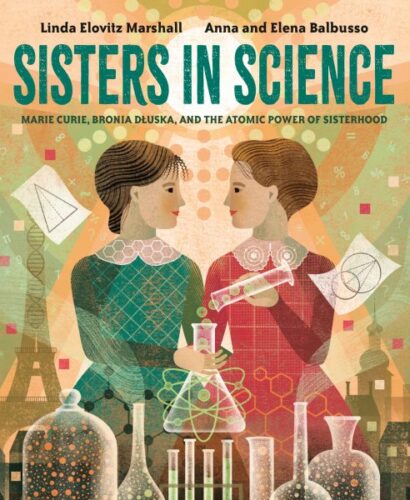
I could live a nice long time without phrases like “the atomic power of sisterhood” but we’ll give it a pass this time. It seems fitting that a sister pair like Anna and Elena Balbusso would work together on a book celebrating another sisterly pair. In this book we learn that Marie Curie’s education was based on a deal. Essentially, there was no way for both Marie and her sister Bronia to simultaneously attend a university, due to lack of funds. The solution? Bronia would go to school first and Marie would work as a tutor to pay for her education. Then Bronia would work while Marie went to school. Were this a fictional story, you just know that Bronia would forget her side of the deal, but as history shows, in this particular case it worked out. As a biography I think it does an excellent job of diverting the focus of Marie Curie away from her relationship with her husband and squarely on her relationship with her sister. As a science text it is perhaps slightly less useful, since at no point is the radiation Marie, Pierre, and Henri discover seen as anything but rah-rah wonderful. Come for the sisterly bond instead. It makes for a great tale.
The Snow Man by Jonah Winter, ill. Jeanette Winter
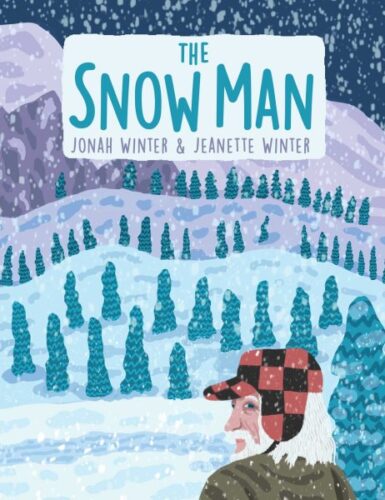
I imagine a person could probably do an entire reclusive-gent-who-likes-snow biography storytime if you combined this book with Snowflake Bentley. That’s a little specific, but it’s true! Odds are you probably haven’t heard of bill barr and odds are that’s how he’d prefer it. Jonah Winter doesn’t name him in the text, even as his tells his story. You’ll have to read the Author’s Note to figure out the true details of the man’s life. You see, back in 1972 billy (lowercase spelling) came to the Rocky Mountains when he was a twenty-one-year-old college student. He holed up in a cabin and started tracking the wildlife. If this sounds a little familiar, that may be because this story isn’t that dissimilar from the one we heard in 2022’s I Begin With Spring: The Life and Seasons of Henry David Thoreau. In both cases a man tracks information about nature for fun and, years later, scientists use those notes to track climate change. Jonah keeps the storytelling lyric and lovely, and the art most certainly helps. It’s an unconventional story of an unconventional citizen scientist. Previously Seen On: The Unconventional List
A Take-Charge Girl Blazes a Trail to Congress by Gretchen Woelfle, ill. Rebecca Gibbon
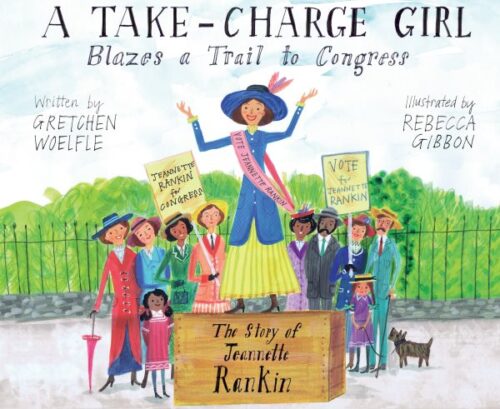
Jeannette Rankin was always a take-charge girl. Whether taking care of horses or her little brothers and sisters—Jeannette knew what to do and got the job done. That’s why, when she saw poor children living in bad conditions in San Francisco, she knew she had to take charge and change things. But in the early twentieth century, women like Jeannette couldn’t vote to change the laws that failed to protect children. Jeannette became an activist and led the charge, campaigning for women’s right to vote. And when her home state, Montana, gave women that right, Jeannette ran for Congress and became America’s first congressWOMAN! One of the better picture bios of Rankin I’ve seen, that’s for sure, and a pretty good example of how you can make a book fun and peppy without having to make up stuff. The backmatter’s pretty darn good but it’s the stuff in the front that will strike you as particularly engaging.
To See Clearly: A Portrait of David Hockney by Evan Turk
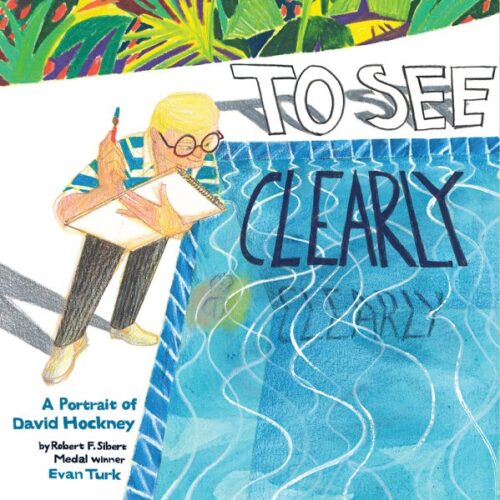
We’re doing the whole artist telling the story of an artist thing again, but I don’t think I would have predicted Turk doing Hockney on my own. After all, they’ve rather different styles when you think about it. Turk has illustrated bios of different artists before, but the last time he did one on Ben Shahn he wasn’t the author. Turns out, the man is quite good at synthesizing a life into a picture book format. Turk isn’t trying to replicate Hockney’s style with this book (a technique that has served some biographer illustrators well but that isn’t a strict requirement). Instead he pulls out his customary colored pencils, gouache, and crayons and goes to town on the whole enterprise. One cannot help but wonder if Hockney will ever see the book himself and, if so, what he’ll think of it. But you know what? Who cares! It’s a dang good biography, making his life not merely pertinent to young readers but interesting as well. Extra points for not eliding over his life as a gay man but for leaning into it as an essential part of his being. Great, grand, and beautiful.
Tomfoolery! Randolph Caldecott and the Rambunctious Coming-of-Age of Children’s Books by Michelle Markel, ill. Barbara McClintock
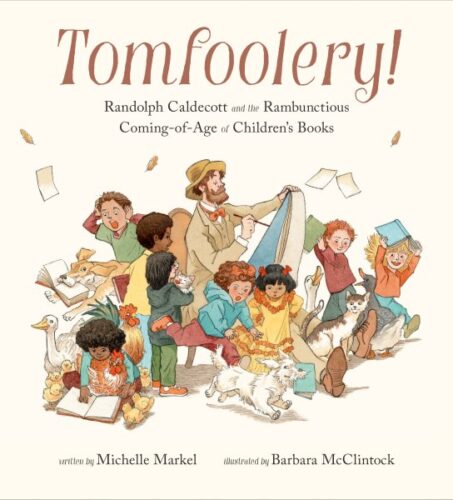
ADVERTISEMENT
ADVERTISEMENT
Meet Randolph Caldecott! The children’s book illustrator unafraid to put fun, action, and loads of animals on the page. A marvelous look at the artist our picture books owe so much to today. Both Markel and McClintock are having a lot of fun with this subject. What they both do so well is stress this change from the solid, staid, stultifying children’s books that preceded Caldecott and what he brought to the form. It never cheats, and yet still manages to have so much fun. Extra points to McClintock for including actual shots of early dull titles (“In Adam’s fall / We Sinned all” and all that). I don’t know that I’ve ever seen her integrate mixed media like this into her art, but she’s a natural. I’m always so happy when she does nonfiction. She’s like a breath of fresh air to the page. And be sure to check out the two-page spread where she’s included a lot of contemporary Caldecott winners (I needed help with the two on the far left, but I know them now). An amazing ode that actually ends up being a really good book of its own. Not easy!
The Van Buren Sisters Vs. The Pants Police by J.F. Fox, ill. Anna Kwan
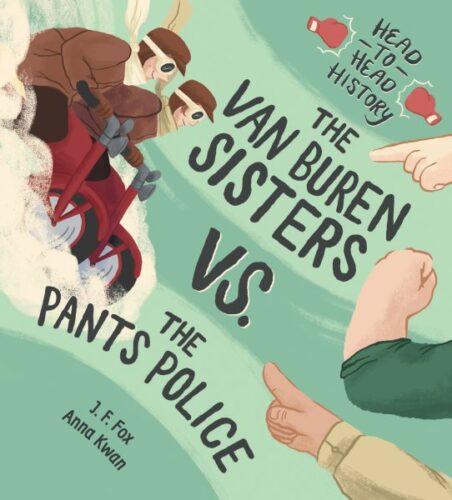
Not the first time Fox and Kwan have pared together on a book. Some of you might recall their Napoleon vs. the Bunnies from a couple years ago. That book was fun, but I’d say this is the more accomplished of the two at the moment. This particular story looks at two motorcycle women from 1916 that kept running into trouble because they preferred to wear pants on their bikes. This certainly falls into the more “fun” category of picture book bios out there, and it eludes one of my usual bugaboos with skill. If you know me then you know that I can’t stand fake dialogue in the text of bios for kids. You know what’s okay, though? Fake dialogue in speech balloons. I think probably because no one expects a cartoon to be strictly factual. Fox and Kwan are clever with this technique too. They make sure to relegate all the statements that people would have made at the time to those balloons, leaving the actual text of the book accurate as all get out. It’s a pretty light and lighthearted little tale, but that backmatter isn’t messing around. We’re talking Glossary, Sources (Print and Digital), Notes, and additional historical information to book. It’s packed! A fun frolicsome look at some very silly laws and the women who enjoyed breaking them.
Virginia Wouldn’t Slow Down: The Unstoppable Dr. Apgar and Her Life-Saving Invention by Carrie A. Pearson, ill. Nancy Carpenter
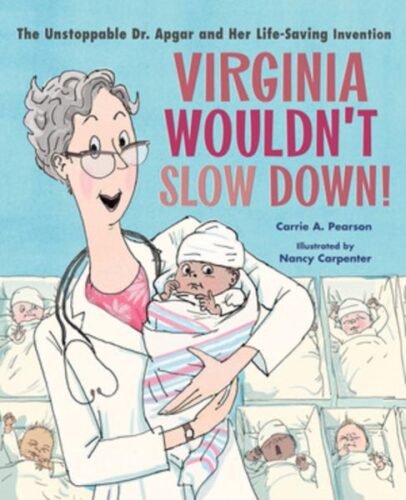
Oh, what a delightful book this is! If you haven’t heard of it, don’t worry. It was just released on August 7th of this year, but it’s great. Author Carrie Pearson has gone above and beyond the call of duty to make Dr. Apgar’s life as fun and interesting as possible. It helps that Nancy Carpenter became the illustrator for this book. She just has a naturally kid-friendly style to her art, though I should mention that she’s changed that style up a little bit for this book. This is a tiny bit broader than her previous titles. That’s not a criticism, just an observation. The story about Apgar and her invention is amazing, mentioning the barriers she faced without allowing them to overwhelm the overarching story. Make sure to also check out the backmatter, which includes not just an Author’s Note but also a Professional Timeline and a mention of Sources (most of which were firsthand, which is impressive in a whole different way).
What Music! The Fifty-Year Friendship Between Beethoven and Nannette Streicher, Who Built His Pianos by Laurie Lawlor, ill. Becca Stadtlander
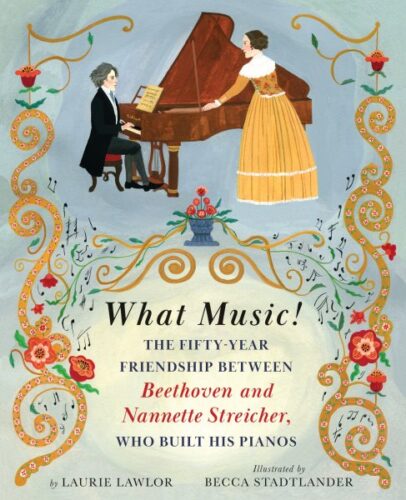
Who the heck says women and men can’t be friends? Now that title, I’ll be the first to admit, is a bit of a mouthful, but ultimately I think Holiday House made the right choice with it. After all, what it does is establish that Nannette Streicher was, almost impossibly, a business woman at a time when that wasn’t really a thing. And let me tell you, after reading countless books about women like Mozart’s sister, who were brilliant but ultimately thwarted, there’s something so deeply satisfying about learning Nannette’s story. Evanston-based author Lawlor herself had to do a slew of original research to get to the gist of this story. As she explains it, “I was inspired to investigate the friendship between Ludwig and Nannette when I discovered more than 60 letters and notes penned between 1817 and 1818. These were all addressed to Nannette. None of her replies survived.” So she dug in and discovered that Nannette tweaked, improved, built, and sold pianos. She managed a family, a business, and designed and refined instruments. But is it actually fun for kids to read? Well, actually, yes. Lawlor cleverly figured out that the heart of this story is Beethoven and Nannette’s relationship. They just really do come off like buddies (and we all know how difficult he was as a person to know). Love the amount of work that Lawlor clearly poured into this book. A great female entrepreneur book and music title AND friendship book all in one.
Hope you enjoyed these! Here are the lists you can expect for the rest of this month:
December 1 – Great Board Books
December 2 – Picture Book Readaloud
December 3 – Simple Picture Book Texts
December 4 – Transcendent Holiday Picture Books
December 5 – Rhyming Picture Books
December 6 – Funny Picture Books
December 7 – CaldeNotts
December 8 – Picture Book Reprints
December 9 – Math Books for Kids
December 10 – Gross Books
December 11 – Books with a Message
December 12 – Fabulous Photography
December 13 – Translated Picture Books
December 14 – Fairy Tales / Folktales / Religious Tales
December 15 – Wordless Picture Books
December 16 – Poetry Books
December 17 – Unconventional Children’s Books
December 18 – Easy Books & Early Chapter Books
December 19 – Older Funny Books
December 20 – Science Fiction Books
December 21 – Fantasy Books
December 22 – Comics & Graphic Novels
December 23 – Informational Fiction
December 24 – American History
December 25 – Science & Nature Books
December 26 – Unique Biographies
December 27 – Nonfiction Picture Books
December 28 – Nonfiction Books for Older Readers
December 29 – Audiobooks for Kids
December 30 – Middle Grade Novels
December 31 – Picture Books
Filed under: 31 Days 31 Lists, Best Books, Best Books of 2023
About Betsy Bird
Betsy Bird is currently the Collection Development Manager of the Evanston Public Library system and a former Materials Specialist for New York Public Library. She has served on Newbery, written for Horn Book, and has done other lovely little things that she'd love to tell you about but that she's sure you'd find more interesting to hear of in person. Her opinions are her own and do not reflect those of EPL, SLJ, or any of the other acronyms you might be able to name. Follow her on Twitter: @fuseeight.
ADVERTISEMENT
ADVERTISEMENT
SLJ Blog Network
Halloween is Coming: 31 New Books to Celebrate Spookytime
Review | Chickenpox
Talking with the Class of ’99 about Censorship at their School
Take Five: New Middle Grade Books in October
ADVERTISEMENT



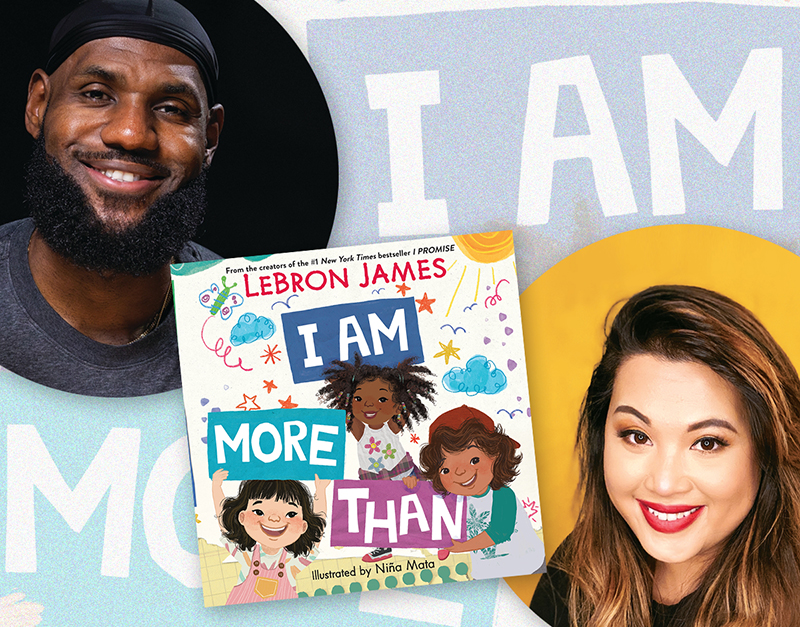
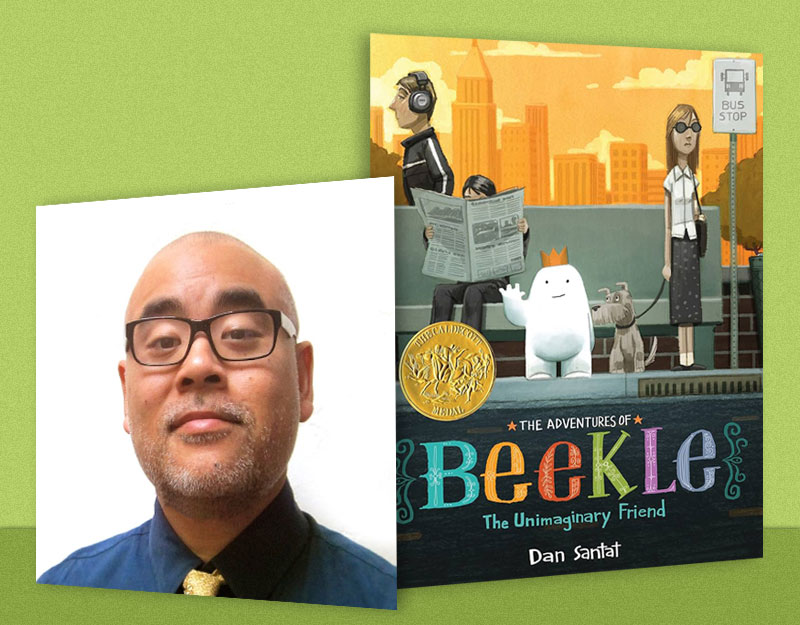


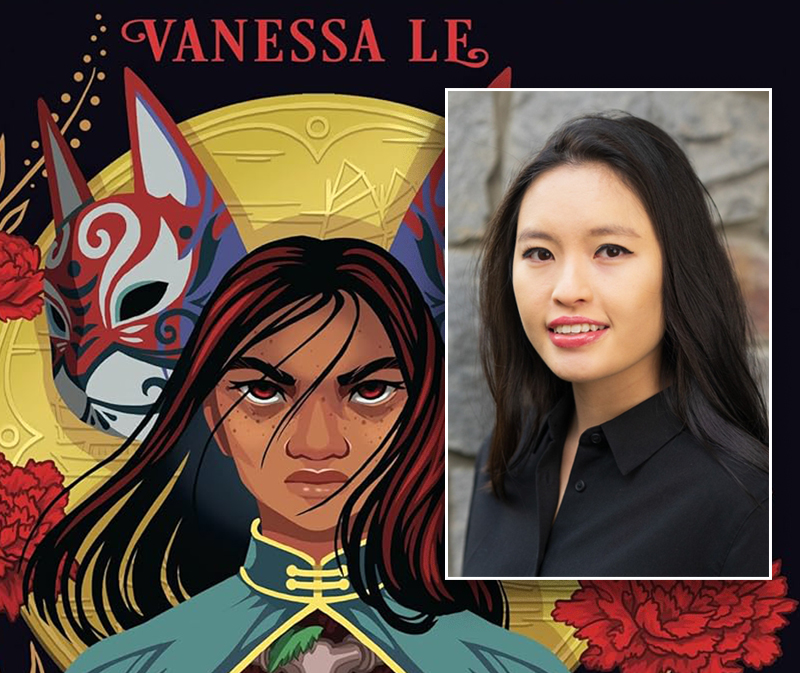
OH. MY. GOD. Desert Queen is on this list with these amazing books – my mind is blown.
Thanks for the love Betsy!
Also I now have to go buy all these books (well not all, I own some of them) so I’m going to either have to figure out what books I can let go, or build new shelves!
Betsy, thanks so much for including Beautiful Noise among these fabulous books! You are right–I did think long and hard about how to approach this bio and have been stunned with how Il Sung Na took my words to a completely new level with his genius. And of course, Anne Schwartz gently and expertly guided this whole project!
Picture book bios are my favorite genre (I adored the Little Books of the Little Brontes, The Green Piano, and all those here I’ve read) and I’m glad to have more on my to-read list!
OMG I am so thrilled to find Imagine a Garden in this list of stellar books. Thank you, Betsy. Wrapping up the year on a high.
Thank you for introducing all these other gorgeous books as well.
Rina
Betsy, I’ve some thoughts about biographies. It seems to me that first a person is given credit for some accomplishment that is recognized and appreciated by others. This might be a form of art, a discovery, an idea that changes understanding, etc. Then comes a desire to learn about the individual behind the accomplishment. I remember learning how to write autobiography in elementary school but most human beings go through life never becoming important enough to have their lives written about. Some families do take time to record information about family members. I love to read about the lives of “accomplishers”.